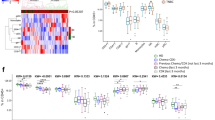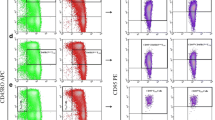Abstract
FoxP3+ CD4+ regulatory T cells (Tregs) are important mediators of peripheral immune tolerance, acting via multiple mechanisms to suppress cellular immunity including antitumor responses. Although therapeutic strategies have been proposed to deplete Tregs in patients with breast cancer and other malignancies, dynamic changes in the Treg compartment as a function of stage and treatment of breast cancer remain poorly understood. Here, we evaluated peripheral blood CD4+ T cells and FoxP3+ CD4+ T cells from 45 patients with early or late stage breast cancer and compared percentages, absolute counts, and Treg function to those from healthy volunteers (HV) of comparable age. Patients having completed adjuvant chemotherapy and patients with metastatic cancer exhibited significantly lower absolute CD4 counts and significantly higher percentages of FoxP3+ CD4+ T cells. In contrast, the absolute counts of circulating FoxP3+ CD4+ T cells did not differ significantly among early stage patients, late stage patients, or HV. Functionally, FoxP3+ CD4+ T cells from all donor groups similarly expressed CTLA-4 and failed to secrete IFN-γ in response to stimulation. Thus, although Tregs comprise an increased percentage of circulating CD4+ T cells in patients with metastatic breast cancer and patients in remission after completing the adjuvant chemotherapy, the systemic Treg pool, as measured by absolute counts, appears relatively constant regardless of disease stage or treatment status. Total CD4+ T cell counts are not constant, however, suggesting that homeostatic mechanisms, or susceptibility to cytotoxic or malignant insults, fundamentally differ for regulatory and non-regulatory CD4+ T cells.





Similar content being viewed by others
References
Baecher-Allan C, Viglietta V, Hafler DA (2004) Human CD4+ CD25+ regulatory T cells. Semin Immunol 16:89–98
Shevach EM (2006) From vanilla to 28 flavors: multiple varieties of T regulatory cells. Immunity 25:195–201
Zou W (2006) Regulatory T cells, tumour immunity and immunotherapy. Nat Rev Immunol 6:295–307
Sakaguchi S, Yamaguchi T, Nomura T, Ono M (2008) Regulatory T cells and immune tolerance. Cell 133:775–787
Camara NO, Sebille F, Lechler RI (2003) Human CD4+ CD25+ regulatory cells have marked and sustained effects on CD8+ T cell activation. Eur J Immunol 33:3473–3483
Thornton AM, Shevach EM (2000) Suppressor effector function of CD4+ CD25+ immunoregulatory T cells is antigen nonspecific. J Immunol 164:183–190
Woo EY, Chu CS, Goletz TJ, Schlienger K, Yeh H et al (2001) Regulatory CD4(+)CD25(+) T cells in tumors from patients with early- stage non-small cell lung cancer and late-stage ovarian cancer. Cancer Res 61:4766–4772
Liyanage UK, Moore TT, Joo HG, Tanaka Y, Herrmann V et al (2002) Prevalence of regulatory T cells is increased in peripheral blood and tumor microenvironment of patients with pancreas or breast adenocarcinoma. J Immunol 169:2756–2761
Wolf AM, Wolf D, Steurer M, Gastl G, Gunsilius E et al (2003) Increase of regulatory T cells in the peripheral blood of cancer patients. Clin Cancer Res 9:606–612
Curiel TJ, Coukos G, Zou L, Alvarez X, Cheng P et al (2004) Specific recruitment of regulatory T cells in ovarian carcinoma fosters immune privilege and predicts reduced survival. Nat Med 10:942–949
Khattri R, Cox T, Yasayko SA, Ramsdell F (2003) An essential role for Scurfin in CD4+ CD25+ T regulatory cells. Nat Immunol 4:337–342
Wildin RS, Ramsdell F, Peake J, Faravelli F, Casanova JL et al (2001) X-linked neonatal diabetes mellitus, enteropathy and endocrinopathy syndrome is the human equivalent of mouse scurfy. Nat Genet 27:18–20
Gavin MA, Torgerson TR, Houston E, DeRoos P, Ho WY et al (2006) Single-cell analysis of normal and FOXP3-mutant human T cells: FOXP3 expression without regulatory T cell development. Proc Natl Acad Sci USA 103:6659–6664
Ahmadzadeh M, Antony PA, Rosenberg SA (2007) IL-2 and IL-15 each mediate de novo induction of FOXP3 expression in human tumor antigen-specific CD8 T cells. J Immunother 30:294–302
Wang J, Ioan-Facsinay A, van der Voort EI, Huizinga TW, Toes RE (2007) Transient expression of FOXP3 in human activated nonregulatory CD4+ T cells. Eur J Immunol 37:129–138
DiGiacomo A, North RJ (1986) T cell suppressors of antitumor immunity: the production of Ly-1-, 2+ suppressors of delayed sensitivity precedes the production of suppressors of protective immunity. J Exp Med 164:1179–1192
Turk MJ, Guevara-Patino JA, Rizzuto GA, Engelhorn ME, Sakaguchi S et al (2004) Concomitant tumor immunity to a poorly immunogenic melanoma is prevented by regulatory T cells. J Exp Med 200:771–782
Ercolini AM, Ladle BH, Manning EA, Pfannenstiel LW, Armstrong TD et al (2005) Recruitment of latent pools of high-avidity CD8(+) T cells to the antitumor immune response. J Exp Med 201:1591–1602
Onizuka S, Tawara I, Shimizu J, Sakaguchi S, Fujita T et al (1999) Tumor rejection by in vivo administration of anti-CD25 (interleukin-2 receptor alpha) monoclonal antibody. Cancer Res 59:3128–3133
Shimizu J, Yamazaki S, Sakaguchi S (1999) Induction of tumor immunity by removing CD25+ CD4+ T cells: a common basis between tumor immunity and autoimmunity. J Immunol 163:5211–5218
Sutmuller RP, van Duivenvoorde LM, van Elsas A, Schumacher TN, Wildenberg ME et al (2001) Synergism of cytotoxic T lymphocyte-associated antigen 4 blockade and depletion of CD25(+) regulatory T cells in antitumor therapy reveals alternative pathways for suppression of autoreactive cytotoxic T lymphocyte responses. J Exp Med 194:823–832
Dannull J, Su Z, Rizzieri D, Yang BK, Coleman D et al (2005) Enhancement of vaccine-mediated antitumor immunity in cancer patients after depletion of regulatory T cells. J Clin Invest 115:3623–3633
Attia P, Maker AV, Haworth LR, Rogers-Freezer L, Rosenberg SA (2005) Inability of a fusion protein of IL-2 and diphtheria toxin (Denileukin Diftitox, DAB389IL-2, ONTAK) to eliminate regulatory T lymphocytes in patients with melanoma. J Immunother 28:582–592
Ruter J, Barnett BG, Kryczek I, Brumlike MJ, Daniel BJ et al (2006) Manipulating T regulatory cells in cancer immunotherapy. Exp Rev Derm 1:589–597
Mahnke K, Schonfeld K, Fondel S, Ring S, Karakhanova S et al (2007) Depletion of CD4+ CD25+ human regulatory T cells in vivo: kinetics of Treg depletion and alterations in immune functions in vivo and in vitro. Int J Cancer 120:2723–2733
Powell DJ Jr, Attia P, Ghetie V, Schindler J, Vitetta ES et al (2008) Partial reduction of human FoxP3+ CD4 T cells in vivo after CD25-directed recombinant immunotoxin administration. J Immunother 31:189–198
Rasku MA, Clem AL, Telang S, Taft B, Gettings K et al (2008) Transient T cell depletion causes regression of melanoma metastases. J Transl Med 6:12
Morse MA, Hobeika AC, Osada T, Serra D, Niedzwiecki D et al (2008) Depletion of human regulatory T cells specifically enhances antigen specific immune responses to cancer vaccines. Blood 112:610–618
Bates GJ, Fox SB, Han C, Leek RD, Garcia JF et al (2006) Quantification of regulatory T cells enables the identification of high-risk breast cancer patients and those at risk of late relapse. J Clin Oncol 24:5373–5380
Wolf AM, Rumpold H, Wolf D, Gastl G, Reimer D et al (2007) Role of forkhead box protein 3 expression in invasive breast cancer. J Clin Oncol 25:4499–4500
Citron ML, Berry DA, Cirrincione C, Hudis C, Winer EP et al (2003) Randomized trial of dose-dense versus conventionally scheduled and sequential versus concurrent combination chemotherapy as postoperative adjuvant treatment of node-positive primary breast cancer: first report of Intergroup Trial C9741/Cancer and Leukemia Group B Trial 9741. J Clin Oncol 21:1431–1439
Jones SE, Savin MA, Holmes FA, O’Shaughnessy JA, Blum JL et al (2006) Phase III trial comparing doxorubicin plus cyclophosphamide with docetaxel plus cyclophosphamide as adjuvant therapy for operable breast cancer. J Clin Oncol 24:5381–5387
Golovina TN, Mikheeva T, Suhoski MM, Aqui NA, Tai VC et al (2008) CD28 costimulation is essential for human T regulatory expansion and function. J Immunol 181:2855–2868
Benjamini Y, Hochberg Y (1995) Controlling the false discovery rate: a practical and powerful approach to multiple testing. J R Statist Soc B 57:289–300
Pillai V, Karandikar NJ (2008) Attack on the clones? Human FOXP3 detection by PCH101, 236A/E7, 206D, and 259D reveals 259D as the outlier with lower sensitivity. Blood 111:463–464
Tran DQ, Ramsey H, Shevach EM (2007) Induction of FOXP3 expression in naive human CD4+ FOXP3 T cells by T-cell receptor stimulation is transforming growth factor-beta dependent but does not confer a regulatory phenotype. Blood 110:2983–2990
Zheng Y, Manzotti CN, Burke F, Dussably L, Qureshi O et al (2008) Acquisition of suppressive function by activated human CD4+ CD25- T cells is associated with the expression of CTLA-4 not FoxP3. J Immunol 181:1683–1691
Ahmadzadeh M, Felipe-Silva A, Heemskerk B, Powell DJ Jr, Wunderlich JR et al (2008) FOXP3 expression accurately defines the population of intratumoral regulatory T cells that selectively accumulate in metastatic melanoma lesions. Blood 112:4953–4960
Kryczek I, Liu R, Wang G, Wu K, Shu X et al (2009) FOXP3 defines regulatory T cells in human tumor and autoimmune disease. Cancer Res 69:3995–4000
Delong P, Carroll RG, Henry AC, Tanaka T, Ahmad S et al (2005) Regulatory T cells and cytokines in malignant pleural effusions secondary to mesothelioma and carcinoma. Cancer Biol Ther 4:342–346
Dejaco C, Duftner C, Schirmer M (2006) Are regulatory T-cells linked with aging? Exp Gerontol 41:339–345
Gregg R, Smith CM, Clark FJ, Dunnion D, Khan N et al (2005) The number of human peripheral blood CD4+ CD25high regulatory T cells increases with age. Clin Exp Immunol 140:540–546
Lages CS, Suffia I, Velilla PA, Huang B, Warshaw G et al (2008) Functional regulatory T cells accumulate in aged hosts and promote chronic infectious disease reactivation. J Immunol 181:1835–1848
Rech AJ, Vonderheide RH (2009) Clinical use of anti-CD25 antibody daclizumab to enhance immune responses to tumor antigen vaccination by targeting regulatory T cells. Ann N Y Acad Sci 1174:99–106
Acknowledgments
We thank Theresa Colligon and Adrianna Recio, RN, and Drs. Daniel J. Powell, Jr., Tatiana Golovina, and James Riley for helpful discussions. This study was supported by grants from the Breast Cancer Research Foundation and the NCI (R01 CA111377) and a gift from Mark and Paula Solomon.
Conflict of interest statement
The authors declare that no conflict of interests exist.
Author information
Authors and Affiliations
Corresponding author
Rights and permissions
About this article
Cite this article
Rech, A.J., Mick, R., Kaplan, D.E. et al. Homeostasis of peripheral FoxP3+ CD4+ regulatory T cells in patients with early and late stage breast cancer. Cancer Immunol Immunother 59, 599–607 (2010). https://doi.org/10.1007/s00262-009-0780-x
Received:
Accepted:
Published:
Issue Date:
DOI: https://doi.org/10.1007/s00262-009-0780-x




